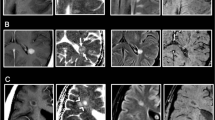Abstract
Background
High field magnetic resonance imaging (MRI) provides higher lesion load measurements in patients presenting with clinically isolated syndromes (CIS) suggestive of demyelination and has impact upon the classification of these syndromes and potentially, the diagnosis of multiple sclerosis (MS).
Purpose
To investigate whether high field MRI can provide an earlier diagnosis of definite MS within the International Panel (IP) and Swanton criteria.
Methods
Forty patients presenting with CIS suggestive of MS were included. All patients received multi-sequence MRI at 1.5 Tesla (T) and 3T as well as a neurological assessment at baseline. Follow-up visits including MRI at both field strengths and neurological examinations were scheduled 3–4 and 6–7 months after the first clinical event. Based on MRI and clinical findings, fulfilled IP criteria as well as Swanton criteria were analysed.
Results
At baseline, the higher detection rate of inflammatory lesions using high field MRI leads to higher classifications according to the Swanton criteria in 15 % of the patients. One additional patient was diagnosed with dissemination in space according to Swanton and IP criteria. During follow-up, an earlier diagnosis of definite MS could not be accomplished, neither according to the IP nor to the Swanton criteria.
Conclusion
Although high field MRI shows a higher detection rate of inflammatory brain lesion in CIS and MS patients with an influence according to MRI criteria, this influence does not lead to an earlier diagnosis of lesion dissemination in time and therefore definite MS.
Similar content being viewed by others
References
McDonald WI, Compston A, Edan G, et al. (2001) Recommended diagnostic criteria for multiple sclerosis: guidelines from the International Panel on the diagnosis of multiple sclerosis. Ann Neurol 50:121–127
Barkhof F, Filippi M, Miller DH, et al. (1997) Comparison of MRI criteria at first presentation to predict conversion to clinically definite multiple sclerosis. Brain 120:2059–2069
Tintoré M, Rovira A, Martinez MJ, et al. (2000) Isolated demyelinating syndromes: comparison of different MR imaging criteria to predict conversion to clinically definite multiple sclerosis. AJNR Am J Neuroradiol 21:702–706
Polman CH, Reingold SC, Edan G, et al. (2005) Diagnostic Criteria for Multiple Sclerosis: 2005 Revisions to the “McDonald Criteria”. Ann Neurol 58:840–846
Nielsen JM, Korteweg T, Barkhof F, Uitdehaag BMJ, Polman CH (2005) Overdiagnosis of Multiple Sclerosis and Magnetic Imaging Criteria. Ann Neurol 58:781–783
Korteweg T, Tintoré M, Uitdehaag B, et al. (2006) MRI criteria for dissemination in space in patients with clinically isolated syndromes: a multicentre follow-up study. Lancet Neurol 5:221–227
Swanton JK, Fernando K, Dalton CM, et al. (2006) Modification of MRI criteria for multiple sclerosis in patients with clinically isolated syndromes. J Neurol Neurosurg Psychiatry 77:830–833
Swanton JK, Rovira A, Tintoré M, et al. (2007) MRI criteria for multiple sclerosis in patients presenting with clinically isolated syndromes: a multicentre retrospective study. Lancet Neurol 6:677–686
Miller DH, Filippi M, Fazekas F, et al. (2004) Role of magnetic resonance imaging within Diagnostic Criteria for Multiple Sclerosis. Ann Neurol 56:273–278
Simon JH, Li D, Traboulsee A, et al. (2006) Standardized MR Imaging Protocol for Multiple Sclerosis: Consortium of MS Centers Consensus Guidelines. AJNR Am J Neuroradiol 27:455–461
Wattjes MP, Lutterbey GG, Harzheim M, et al. (2006) Higher sensitivity in the detection of inflammatory brain lesions in patients with clinically isolated syndromes suggestive of multiple sclerosis using high field MRI: an intraindividual comparison of 1.5T with 3.0T. Eur Radiol 16:2067–2073
Nielsen K, Rostrup E, Frederiksen JL, Knudsen S, Mathiesen HK, Hanson LG, Paulson OB (2006) Magnetic resonance imaging at 3.0 Tesla detects more lesions in acute optic neuritis than at 1.5 Tesla. Invest Radiol 41:76–82
Wattjes MP, Harzheim M, Kuhl CK, et al. (2006) Does high-field MRI have an influence on the classification of patients with clinically isolated syndromes according to Current Diagnostic Magnetic Resonance Imaging Criteria for Multiple Sclerosis? AJNR Am J Neuroradiol 27:1794–1798
Bot JCJ, Barkhof F, Polman CH, et al. (2004) Spinal cord abnormalities in newly diagnosed MS patients: added value of spinal MRI examination. Neurology 62:226–233
Dalton CM, Brex PA, Miszkiel KM, et al. (2003) Spinal cord MRI in clincially isolated optic neuritis. J Neurol Neurosurg Psychiatry 74:1577–1580
Author information
Authors and Affiliations
Corresponding author
Rights and permissions
About this article
Cite this article
Wattjes, M.P., Harzheim, M., Lutterbey, G.G. et al. Does high field MRI allow an earlier diagnosis of multiple sclerosis?. J Neurol 255, 1159–1163 (2008). https://doi.org/10.1007/s00415-008-0861-3
Received:
Revised:
Accepted:
Published:
Issue Date:
DOI: https://doi.org/10.1007/s00415-008-0861-3




